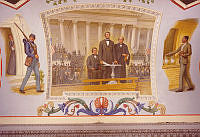Rubenstein Center Scholarship
Enslaved Workers on the White House Grounds
This article is part of the Slavery in the President’s Neighborhood initiative. Explore the Timeline
Uncovering the lives of enslaved people poses many challenges. Because enslaved people were denied the right of literacy, as a result, most did not leave behind written records of their lives or experiences. The enslaved were also treated as commodities to be bought and sold, rather than as human beings, further excluding their thoughts and voices from the record. Therefore, it is often difficult to uncover the identities, lifestyle, and details of the enslaved individuals that contributed to White House history. Due to the unpredictable nature of this historical research, we must consider diverse sources to piece together a more complete picture of slavery at the White House.
In the case of President James Monroe (1817-1825), the White House Grounds are an unusual source for discovering more about the lives of enslaved African Americans that labored at the Executive Mansion.1 These individuals were separate from Monroe’s enslaved household in the White House. During this time period, the grounds surrounding the White House underwent several phases of construction and rehabilitation. After the British burned the White House in 1814, the home was quickly rebuilt, and President Monroe moved into the still unfinished President’s House in October 1817. For the next several years, work continued on the building’s interiors and the White House Grounds.2 In 1818, Monroe appointed Charles Bulfinch as the Architect of the Capitol to complete the Capitol Building. At the same time, Monroe also sought Bulfinch's advice on the grounds. As a result, Bulfinch submitted plans for improvements to the landscape, likely including grading in the President’s Square just north of the White House; construction of a new north entrance; and the addition of new sections of stone wall and iron fencing. Unfortunately, Bulfinch’s designs have been lost to history. However, congressional appropriations and payroll records provide some clues about these construction and improvement projects.3 Click here to learn more about the enslaved households of President James Monroe.

This watercolor painted in 1827 by an anonymous artist depicts the White House and its grounds from the southwest. The watercolor shows the recently built South Portico, constructed during the Monroe administration, President Thomas Jefferson's stone walls, workers' cottages, an orchard, and President John Quincy Adams' tree nursery.
Anthony St. John Baker, Memoires d'un voyageur qui se repose: With illustrations.... (London: Priv. print., 1850), RB 286000, The Huntington Library, San Marino, California "President's House, Washington";White House and Capitol, c. 1826 [watercolor]Treasury vouchers demonstrate that the federal government employed a large labor force from 1818 to 1834 to work on these projects. The National Archives and Records Administration’s Record Group 217 contains the papers of Samuel Lane, the Commissioner of Public Buildings for Washington, D.C. in an “Auditors Report on the Account of Samuel Lane, Late Commissioner of Public Buildings.”4 Within these documents are monthly payrolls spanning from 1818 to 1821, which reveal the names of thirty-two enslaved individuals and numerous free workers that labored on the White House Grounds. The monthly payrolls record work completed on “the President’s Square,” “the President’s House,” “Coppering the roof of the President’s House,” “the Wall & Gates North of the President’s House, and “the Yard & Wall North of the President’s House.”
Sometimes the historical documentation clearly indicates the enslaved or free status of workers. For example, a man named Peter first appeared on a July 1818 payroll for work done on the President’s Square, the area known today as Lafayette Park. He is recorded as a pickax man or “picker,” making $1.12 a day for “16 1/4” days of work and earning a total of $18.28 for the month. His enslaved status is evident because he is listed not by his full name, but as “Murray’s Peter.” Instead of signing his own name to collect his wages, as the free laborers did, his owner signed for him—"Thos. Murray.”5
The “Thos. Murray” on the payroll was a man named Thomas Murray. He also appears on the payroll twice for the month of July for his work as a “carter.” Murray rented out two carts for the work done on the President’s Square. Murray was paid “22 1/4” days for his first cart at $2.00 per day and five days for his second cart at the same rate. In total, Murray took home $54.50 for the use of his carts that month. However, he also took home an additional $18.28 for the labor of his enslaved picker, Peter, bringing his monthly earnings to $72.78. It is important to note that Murray was paid $0.88 more per day for the use of his carts than for the physical labor of Peter, a human being.6

The individuals listed here labored on the White House Grounds in 1818. Click here to see a full index of the enslaved individuals working at the White House.
White House Historical AssociationMurray took part in the practice of “hiring out.”7 This exchange was particularly common in cities where slave owners typically required fewer enslaved people to manage households in comparison to rural plantations, where owners relied on large numbers of enslaved laborers to plant, maintain, and harvest cash crops. To make extra money, urban slave owners would hire their enslaved workers out for wage labor. The enslaved person would provide the labor, while the contract holder would pay a wage directly to the owner. These contracts could be formal—hiring workers quarterly or by the year for their labor. They could also be informal, paying for work on a monthly as needed basis. Since individuals like Peter were only recorded working a couple of months, it is likely workers were assigned jobs on a short-term basis. In this case, the laborer was Peter, the person pocketing the wages was Thomas Murray, and the contract holder was the Commissioner of Public Buildings, Samuel Lane.8
The money for the labor of enslaved people like Peter came directly from Congress. On April 20, 1818, Congress passed an appropriations bill which stated the following:
“For finishing the President’s house, fifteen thousand two hundred and fourteen dollars...For the wall north of the President’s house, with gates and iron railing the width of the house, three thousand five hundred and eighteen dollars. For contingencies, four hundred and thirty-seven dollars.”9
This sum was a significant amount of money for the time, and these appropriations allowed for the procurement of materials and the hiring of labor to complete tasks in a timely manner. While there is no known evidence that the federal government purchased enslaved people to complete public construction and building projects in the capital, there are many examples of government officials and project overseers hiring enslaved labor on contract. This practice began in 1792, when the first commissioners for the Federal City contracted enslaved labor to build the White House and the Capitol Building.
Peter continued to work on the President’s Square project through November 1818 alongside other enslaved workers like Charles.10 Charles first appeared on the June 1818 payrolls for work in the President’s Square. He was listed as a laborer earning $1.00 a day for fourteen days of work. His labor was considered more generalized and unskilled than the work of a “picker” like Peter, so his owner was paid $0.12 less per day. Charles is listed as “Rich? S. Briscoe Chas” and his owner signed for his wages in large, clear handwriting—"R.S. Briscoe.”11

This payroll records labor on the President's Square for the Month of June 1818. The payroll records two enslaved men--"Bennett Jarbos Isaac" and "Rich S. Briscoe Chars."
National Archives and Records AdministrationThe R.S. Briscoe on the document was a man named Richard S. Briscoe. According to the 1820 census, Briscoe lived in Washington Ward 1 and owned a total of eight enslaved individuals: one male fourteen to twenty-five, one male twenty-six to forty-four, three females under fourteen, and two females fourteen to twenty-five.12 Although the names of the enslaved were not recorded on the census, it is likely Charles was the male aged fourteen to twenty-five. Most day laborers fell within this age range, and Charles probably would have needed to be in excellent physical condition to perform generalized labor on the President’s Square project. It is also possible that he would not have been recorded with Briscoe on the 1820 census. Enslaved people could be sold by their owners at any time and Charles does not appear on any payrolls after December 1819. Perhaps his labor was not required on later projects, but it is also possible that he was no longer owned by Briscoe or was hired out to someone else. Due to the scarcity of information about Charles’ life, it is difficult to develop a more complete picture.
However, there is one other thing we do know about Charles. Although he is referred to as “Rich Briscoes Chas” throughout the summer and fall of 1818, when he reappeared on the payroll for work done on the “Wall and Gates North of the President’s House” in November 1819, he is instead recorded as “Charles Shade.” Richard Briscoe still signed for his wages, but his last name was recorded on the rolls. The recording of an enslaved person’s last name on these payrolls varies. Often, enslaved individuals were listed with their owner’s last names. While they may have used their owner’s last name, it is also possible that they had a separate family last name which went unrecorded, making it even more difficult to trace individuals in the historical record. Although no further information has been discovered about Charles Shade beyond these payrolls so far, we hope the inclusion of his last name will allow us to find more information about him.13

The individuals listed here labored on the White House Grounds in 1819. Click here to see a full index of the enslaved individuals working at the White House.
White House Historical AssociationSampson and Thomas Nutter were also listed with a different last name than their owners. Sampson worked the most, laboring from August 1821 through December 1821. Thomas appears for the month of September 1821 as a laborer. Both men were paid $0.75 per day to copper the roof of the White House. James Handy signed for their wages. James H. Handy appears in the 1820 census for Washington Ward 1 with six enslaved individuals, including a male under fourteen, a male fourteen to twenty-five, a male twenty-six to forty-four, a female under fourteen, and a female fourteen to twenty-five. The fact that Handy hired out two of his enslaved workers indicates that he could spare the labor in his household and likely hoped to reap the financial reward of hiring out multiple enslaved people.14
Handy was not the only person to hire out multiple enslaved workers for the same project. Andrew Elzey, Leven Elzey, and William Elzey all appear on payrolls, hired out by a woman named Henrietta Elzey. Andrew Elzey worked on the President’s Square in April 1820, and on the yard and gates North of the President’s House in September 1820, both times earning $0.75 per day. It appears Andrew was called in as needed or only for a certain number of days. He only worked eight days in April and “3 3/4” days in September. Similarly, Leven Elzey was only recorded for September 1819, earning $0.75 per day for just “5 1/4” days of work. William Elzey worked the most, appearing on payrolls for October and November 1819. He earned $0.88 per day as a laborer on the walls and gates for five days of work in October and fifteen days of work in November.15

The individuals listed here labored on the White House Grounds in 1820. Click here to see a full index of the enslaved individuals working at the White House.
White House Historical AssociationUnfortunately, genealogical information concerning the enslaved Elzeys is scarce. However, the slave owner, Henrietta Elzey, does appear in various records. Henrietta was married to a doctor named Arnold Elzey from Somerset County, Maryland. He died in the District of Columbia on June 6, 1818.16 Therefore, Henrietta would have been the head of her household during 1819 and 1820 when Andrew, Leven, and William appeared on these payrolls. Although many people assume that all slave owners were men, some women actively owned enslaved people. Some purchased their own enslaved people while others inherited individuals from spouses or family members. In the wake of her husband’s death, it is likely Henrietta, a woman in her fifties, relied on hiring out enslaved people for income and to supplement her inheritance.17 Although Henrietta lived in Washington at the time of her husband’s death, she curiously does not appear in census records until 1850. In the 1850 census, she is listed with a twelve-year-old black girl named Catherine Wilson.18 That same year, Henrietta drafted her last will and testament. She mentioned her enslaved people in this document, resolving to “give to the following colored persons, as follows, old Milly who was once my slave, twenty five dollars, to be paid one half in one year and the balance in two years after my decease…” In addition to giving twenty-five dollars to the formerly enslaved Milly, Henrietta also stated the following:
“As it has been my wish to manumit all my servants, should it appear that in any case their freedom is incomplete or doubtful. I hereby declare them all free and manumitted after my death. And I hereby authorize and require the executors of this my last will and testament to execute and deliver to every of said manumitted slaves who may desire the same, such writings and instruments in law as may be necessary to secure to every such manumitted slave the full enjoyment of his or her freedom.”19

This page of Henrietta Elzey's last will and testament leaves the following instructions: "As it has been my wish to manumit all my servants, should it appear that in any case their freedom is incomplete or doubtful. I hereby declare them all free and manumitted after my death. And I hereby authorize and require the executors of my last will and testament to execute and deliver to every of said manumitted slaves who may desire the same, such writings and instruments in law may be as necessary to secure to every such manumitted slave the full enjoyment of his or her freedom."
AncestryUnfortunately, Henrietta did not list any of the enslaved people mentioned in this document by name. Furthermore, the 1850 census suggests that these individuals did not live with her. Henrietta likely continued to hire out her enslaved people for contract work throughout the city as she did in 1819 and 1820. It is possible that Henrietta still owned Andrew, Leven, and William at the time of her death in 1852.20
Although work continued on the White House Grounds until 1834, it appears that enslaved labor was primarily confined to the earlier years of construction, 1818 to 1821. Later payrolls do not indicate the use of enslaved labor. The decrease in the use of enslaved labor is consistent within the context of the time period. The continued development of Washington into an urban center lessened the demand for enslaved labor, making it more profitable for the city’s slave owners to sell their enslaved workers to the Lower South, where cotton plantations were on the rise. In addition, abolitionists increased their attention on the nation’s capital, publicly challenging the immorality of the institution and condemning those that participated in and profited from it.21

The individuals listed here labored on the White House Grounds in 1821. Click here to see a full index of the enslaved individuals working at the White House.
White House Historical AssociationAdditional research into the lives of the enslaved individuals that labored on the White House Grounds is ongoing, as historians hope to learn more about the identities and life experiences of the thirty-two identified enslaved individuals, and any others that remain unknown. If you have additional information about any of the enslaved individuals discussed or listed here, please reach out to the White House Historical Association’s Slavery in the President’s Neighborhood initiative at SPN@WHHA.org.





